Zen Meditating, While Hiking in the Mountains
Written by: Ewan Magie
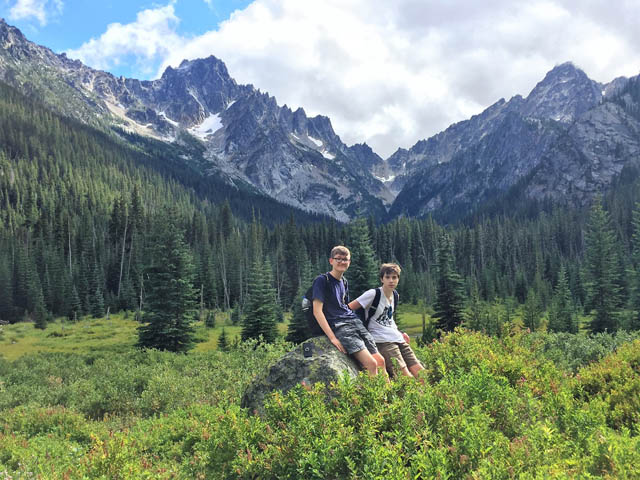
Yoshi Hose and friend Aiden reflect in silence along the trail to Stuart Lake, in Washington state’s Cascade Range.
Every month members of Seattle Soto Zen practice while hiking, a step off the cushion they call mountain meditation. This complements their twice-weekly sitting meditation sessions at their zendo, near the shore of Seattle’s Lake Washington Ship Canal.
The roots of this hiking meditation practice go back to China’s 8th century Tang Dynasty, and even earlier to the mendicant monks of original Buddhist practice in ancient India. During the rainy season monastics sat and meditated in their monasteries, alternating periods of sitting with periods of meditative walking. When the rains stopped the monks wandered widely, their journeys becoming practice itself.
Since 2010, people going on Soto Zen mountain meditation hikes have rendezvoused at 7 a.m. at the Ravenna Park-and-Ride in North Seattle, beneath the gray industrial pillars of Interstate 5. Once gathered the group strolls to the nearby Bus Stop Espresso, where longtime barista Rion Peoples chats us up, brews our drinks, asks where we are headed.
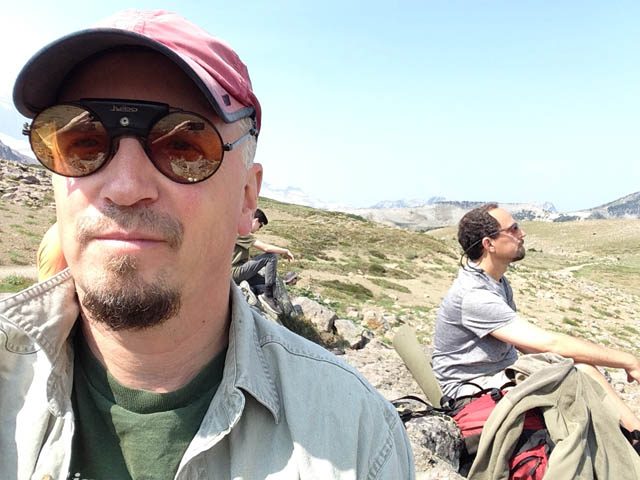
I lead the mountain meditation groups, while guiding teacher Jeff Kelley leads Seattle Soto Zen. He joined in 2009, after years practicing at the Clouds in Water Zen Center in St. Paul, Minnesota. Therefore Seattle Soto Zen is connected to the Katagiri Roshi lineage in Minnesota, and to the Suzuki Roshi lineage, through our affiliation with Norman Fischer and Everyday Zen.
The monthly mountain meditation hike opens each practitioner to the wider, open field of awareness. Our approach is patterned after the practice of Dongshan Liangjie, a 9th century Chinese monk who was famous for his wandering, and who founded our school of Soto Zen practice.
Leaving his teacher after years of study, Dongshan saw his own reflection when crossing a mountain stream. He wrote:
I now go on alone; everywhere I meet it.
It now is me; I now am not it.
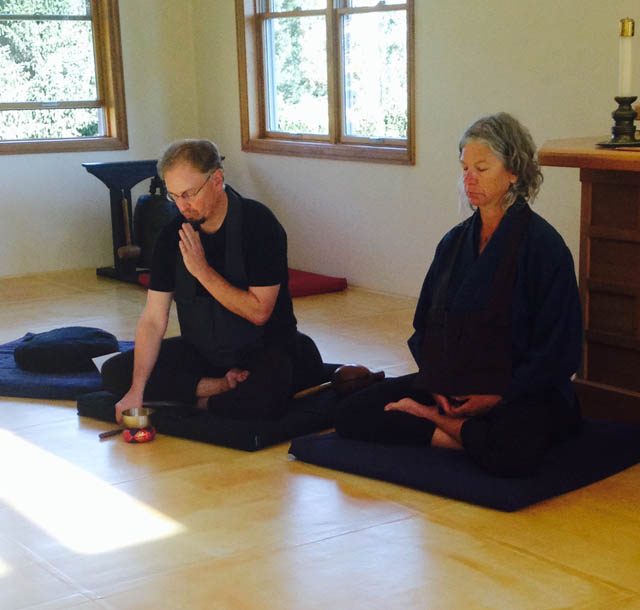
Dongshan saw, in that moment, the wider field beyond the self. Meditative hiking practice is simple, yet beneath its everyday appearance is the practice of suchness, being present with what arises, within and without.
As we hike we pay attention to things as they are, inside and outside. We hike in silence, sitting periodically in the woods, or beside the trail. Whether circled beneath the dark firs, or atop some cliff with expansive views, our meditation practice “turns the light inward to study the self,” words attributed to another Zen master, Dogen.
While hiking, meditation practice meets the wide-open expanses of local wilderness. Yet it carries an inward-studying habit of noticing what is arising within us, in our body, speech, and mind. Practicing in the mountains provides a retreat-like environment of quiet and openness.
As we hike we feel and notice fully each step, each breath. Awakening occurs in every moment; always we return to mindful awareness. Always each practitioner notices, then lets go the habits of mind and heart, opening awareness to a wider, vaster field.

A day practicing in the mountains
Typically we hike in the Cascade Range of mountains east of Seattle, usually along the I-90 corridor. On wet days in autumn or spring, we tend to hike closer to town; in the high season of July, August, and September, we hike wilder reaches of the Alpine Lakes Wilderness, going deep into the silence of woods and peaks and mountain streams.
Like the monk Dongshan, we cross many streams and gaze into calm mountain pools, allowing the clatter of our busy modern minds to settle like so many sand grains nestled and gleaming in pure, clear water.
In the summer of 2018, a typical group of seven meditating hikers drove all the way up the Teanaway River Road, and then climbed the steep trail to Iron Peak. Climbing slippery, rocky switchbacks through ponderosa pine forest, we left the overcrowded dirt road and its hordes of shiny SUVs. In a quarter mile or so, we stepped off the trail and sat amongst granite boulders for a brief meditation.
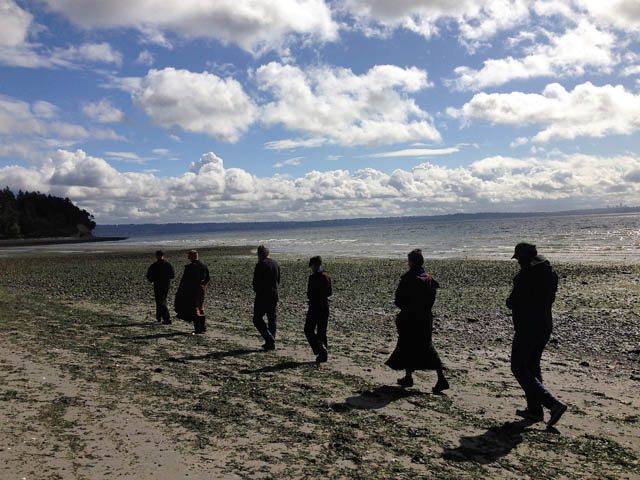
Here’s a combination of prose and poetry I wrote, to capture these moments:
Small brass Tibetan bells ring in empty sky beside the swift gully stream; each of us opening our mind and all our senses, taking in the vanilla scent of the pines, the rush of cool waters, and the looping habit patterns of our minds and emotions. Yet the mountains provide a retreat-like atmosphere, one enhanced by the silence and stillness that upright meditation posture provides.
The dusty world of grinding gears and traffic falls away, allowing our body-heart-mind to settle into a quiet where each hiker-meditator sees her or his long-standing habits of thought. Each begins to touch an inner stillness and focused equanimity.
In the turning waters of the river, in the eddy’s swirl and foam, dark green depths, layer upon layer that somehow serves as mirror.
I clatter along, boots scattering stones.
Stopping, I stare at the rush and flow. I’ve come here again, as walking up and down the river settles my scattered mind, relieves the beleaguered heart.
Yet what do I think I see, gazing at the river time after time? What is it but water and flow, slant of topography, refuge from city and social strain?
Silver light shines on stainless steel, morning light on the doorframe. Silence in early hours lets things be as they are.
From the zafu, black as a shaving of coal, the quiet gathers round. The bell rings and a pair of pale hands serve tea in round, handleless cups, the liquid steaming in sunlight. Clackers sound their sharp wooden sound.
All sip, then set down the small vessels. Everyone eats a cookie, moistening fingers to collect crumbs. Clacking again, the sitting company rises together, then bows – an assembly of black-robed figures, hinged at the waist. In silence, they file out, bare feet across a wooden floor.
The trail along the river is a corridor through green salmon berry, dark firs towering overhead. Rush of river water fills the ears.
Scent of moss and skunk cabbage permeates moist air. Grey light of clouds fills the gaps beyond the leaves above.
Step by step, boots clamber upwards, from forest valley towards the soaring summit.
Somewhere along the way, thoughts drop off and hikers lift cups of cold water, breathe fresh mountain air, gaze out across miles of ridgelines, home to countless hawks who hover a few moments, then glide away.
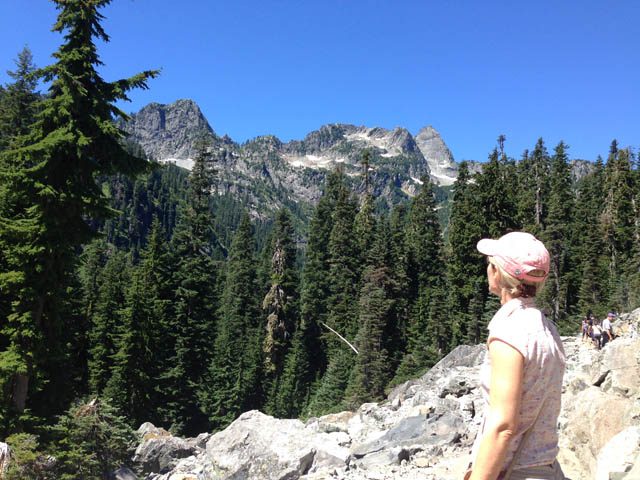
Climbing higher the switchbacks steepen; we climb through an alpine clearing, see the steepest aspects of the high pass ahead. Nearing the summit one of our older hikers, Terri Clark, holds up her boot sole. In silence and sunlight, we smile together. As she lifts her now-flatter boot, I realize it’s now a leather shoe without a sole.
Clark shrugs, her long gray hair falling off her shoulder, and with gleaming eyes we hike the last few slippery steps to a broad shoulder. The far valleys fall away, opening to further peaks. Between a fissure in vertical rock we can see the steep grey pyramid of Mount Stuart, tallest non-volcanic peak in Washington state.
As we wonder at the crown jewel of the entire Stuart Range, we do a brief verbal check-in while we eat our lunch. In silence we then carry on towards the summit of Iron Peak. A longtime hiker and meditator, Clark is calm and collected, even with a boot with no sole.
Blue skies and sunlight and clear mountain air become our meditative companions. The pines of the meadows fall away, and all our heart-minds open to the wide expanses; ridge after ridge crinkle in elongated lines below.

The rocks below our boots become progressively more orange as we near the throne seat of Iron Peak. Tiny purple flowers blossom between thin cracks in the orange rock. We sit another 10-minute meditation on the summit rocks; each of us finds our minds clearer, our hearts at ease in the heart of the day. Each of us smiles, recognizing this is why we came, why we love this monthly ritual.
As we descend, our feet hot and dusty, our bodies sore from the long day, we relax into an easy shuffle. We know we’ll make a slow, relaxing drive back down the dirt road, eat Mexican food in a family-run restaurant in the town of Cle Elum. Then we’ll roll home over Snoqualmie Pass, returning to the Ravenna Park-and-Ride after dark.
Next year we will continue this decade-long retreat tradition. Mountain meditation will resume in June, and in deep summer we will do some overnights, deepening our commitment to exploring the wilderness of the Cascade Range. At the same time we will deepen our meditative exploration of everything that arises in our hearts, bodies, and minds.
The year 2019 promises wide open trails, clear mountain streams and pools, expansive explorations wide and wild. Won’t you come and join us?
Ewan Magie is a longtime meditator and explorer of the Pacific Northwest. He began meditation practice in 2008 with Seattle Insight Meditation Society and founding teacher Rodney Smith. Beginning in 2010, he has led mountain meditation hikes for Seattle Soto Zen, which is guided by teacher Eko Jeff Kelley. Inspired by a lifelong love of hiking and exploring mountains, he has also been inspired by Zen monks and ancient Indian mendicants who wandered the wilds, seeking awakening.
Since 2002 he has taught as an English professor at local junior colleges, particularly Bellevue College and the Seattle colleges. Poet and essayist, he has published widely, including in Northwest Dharma News.
